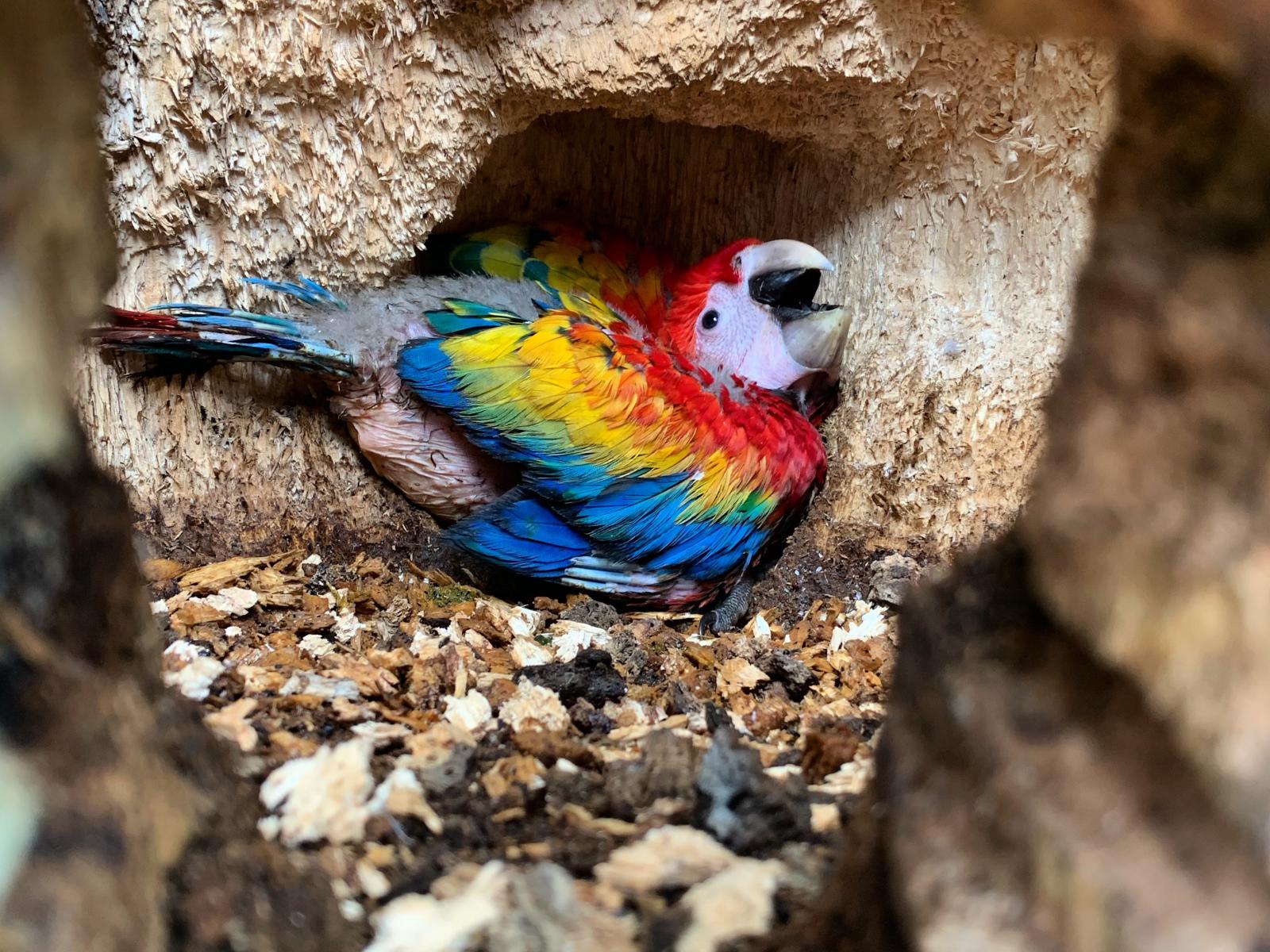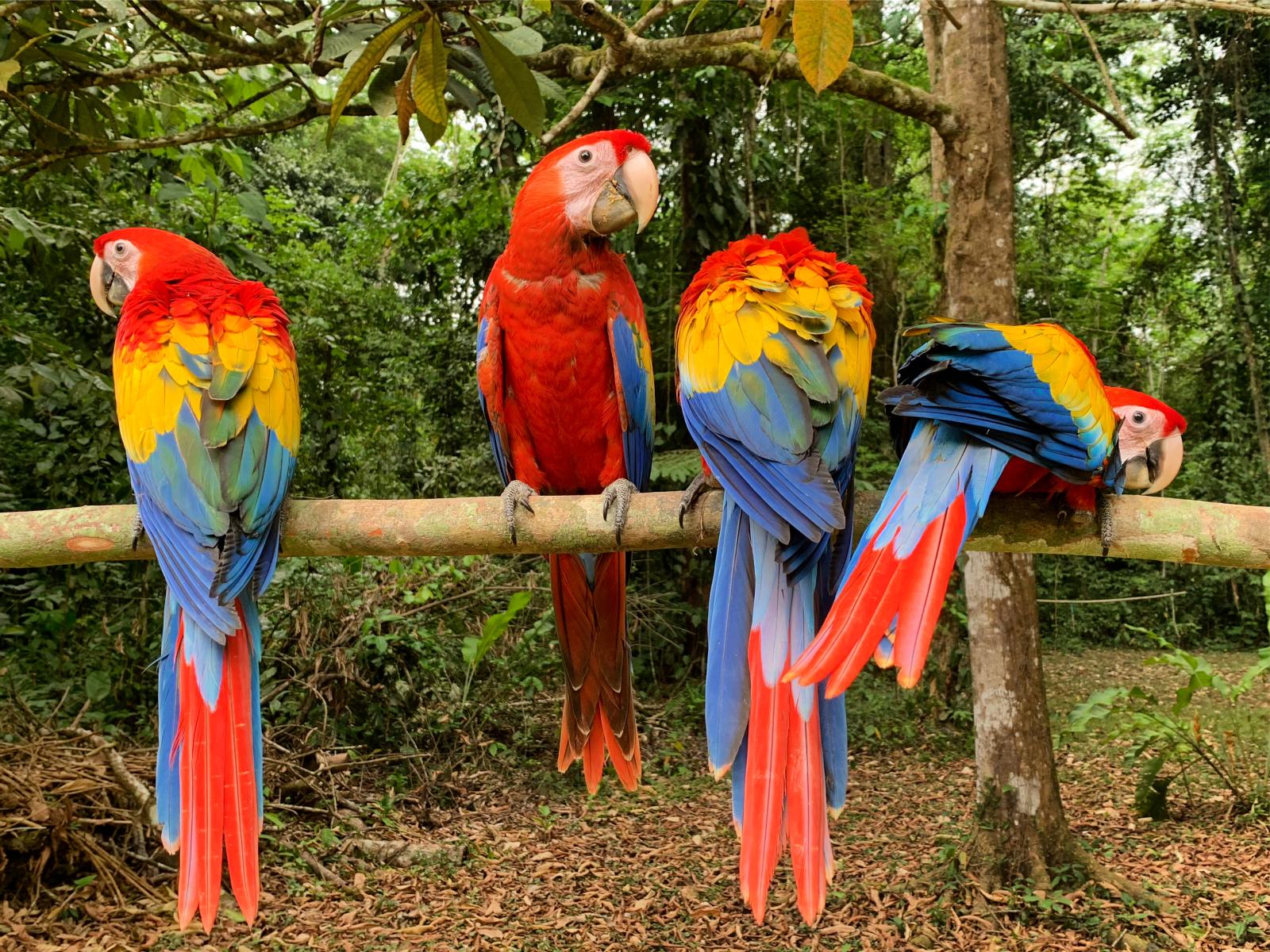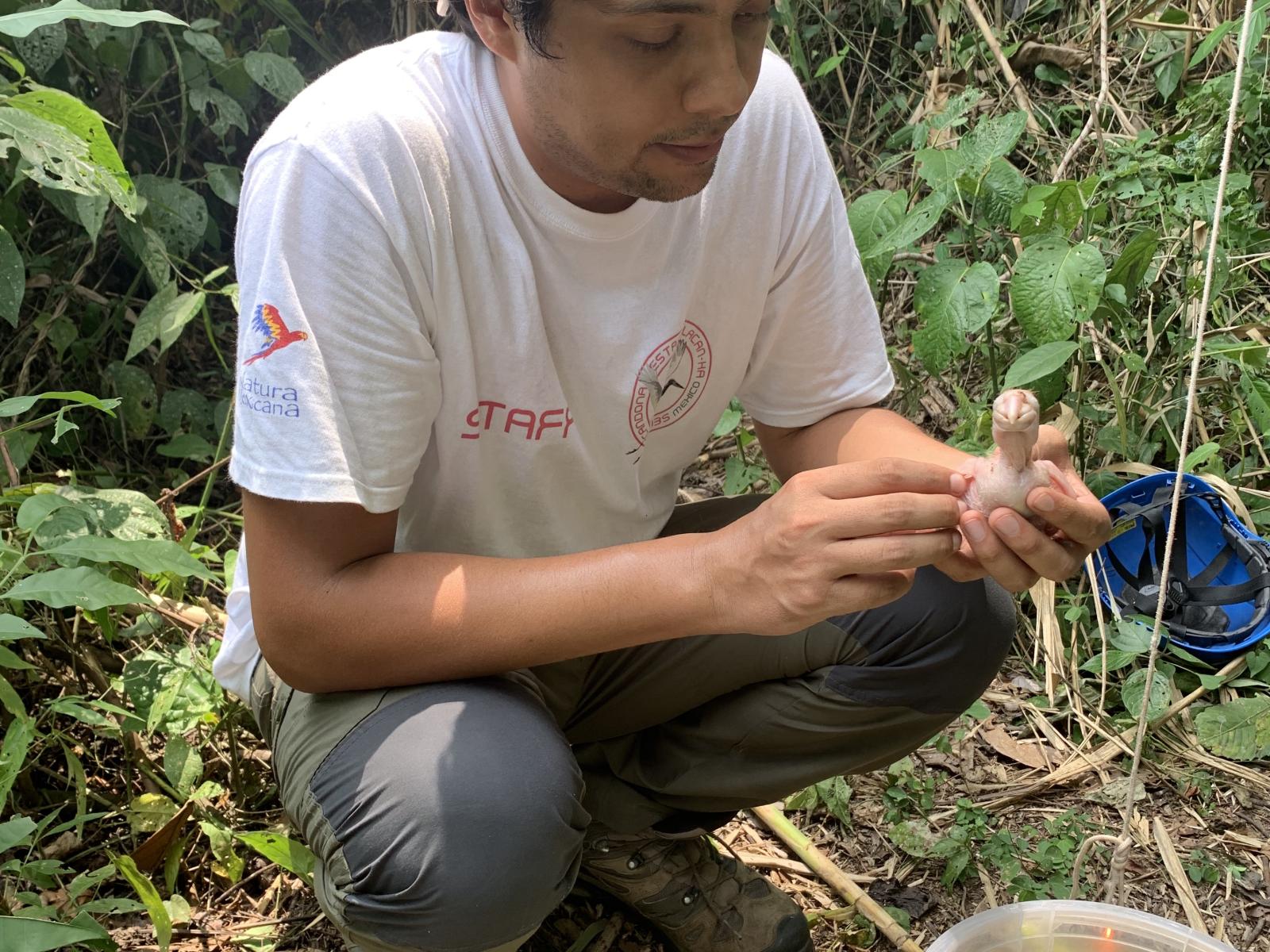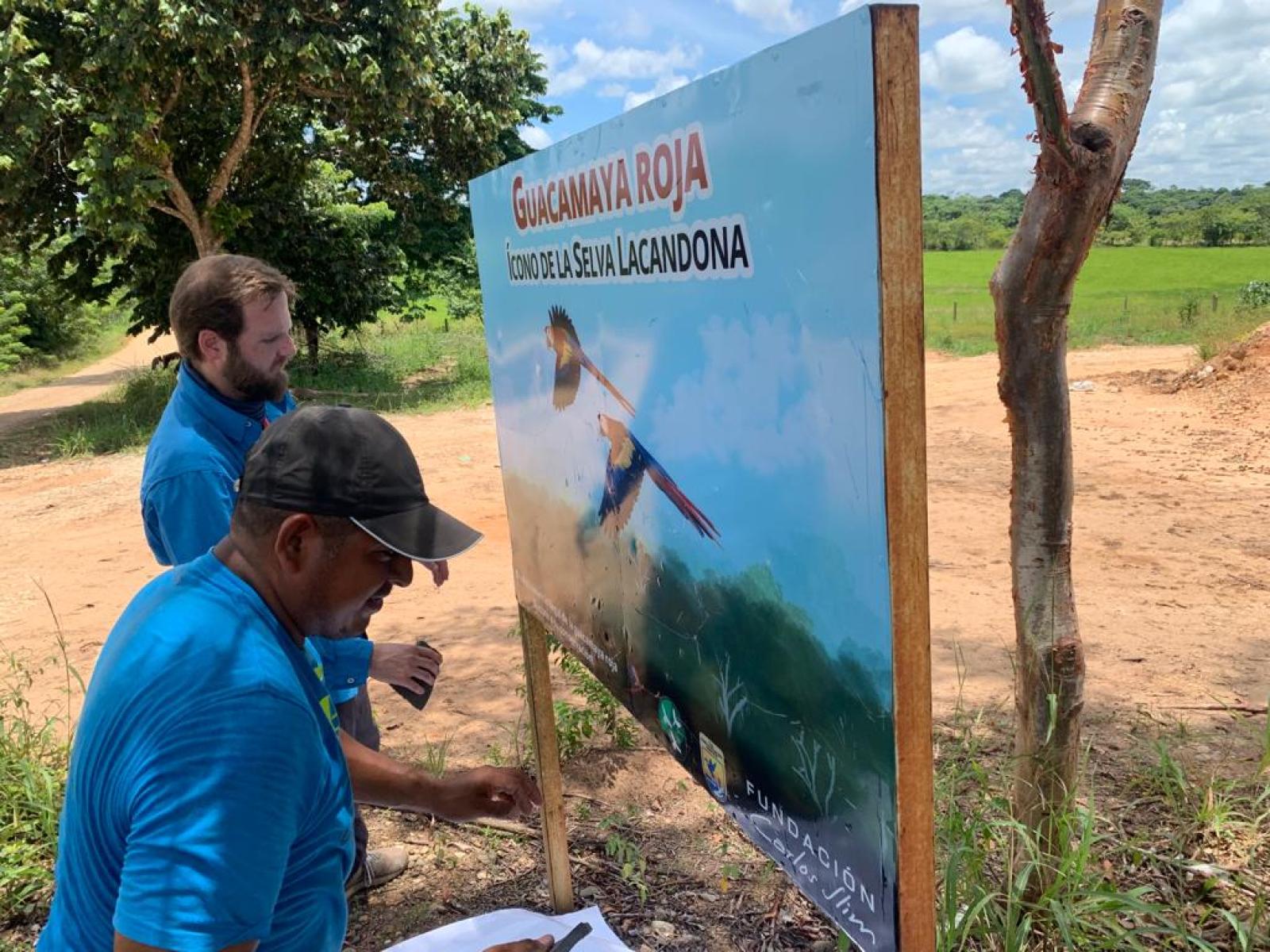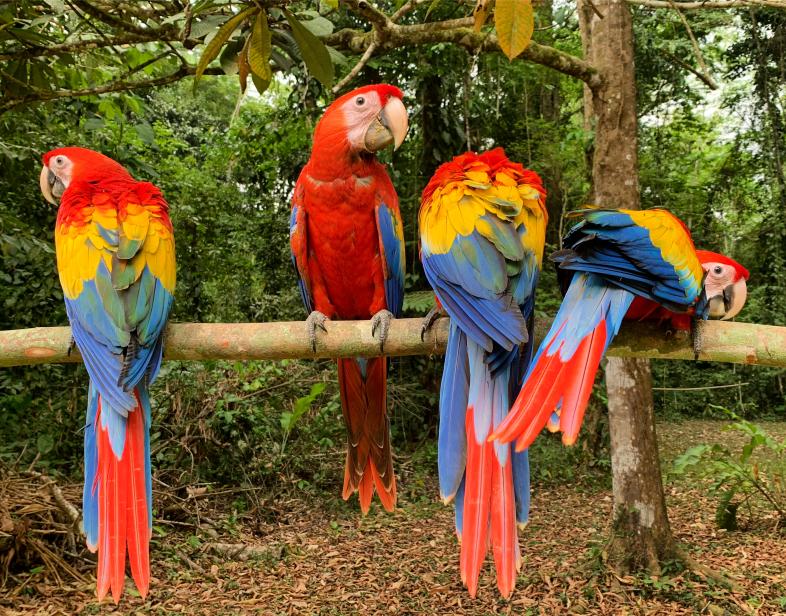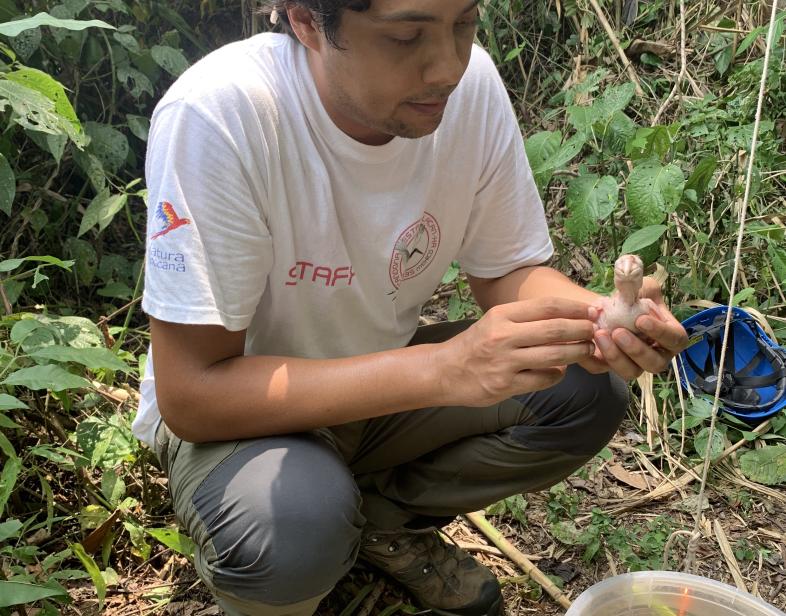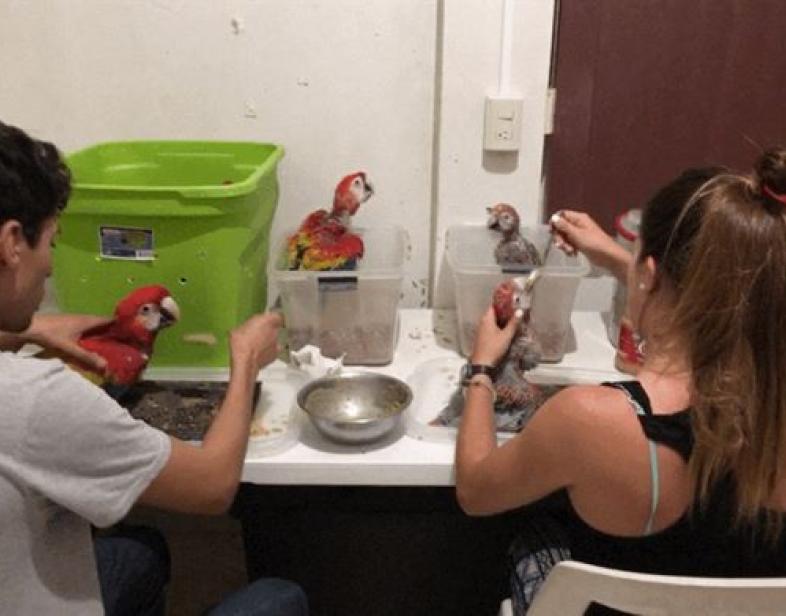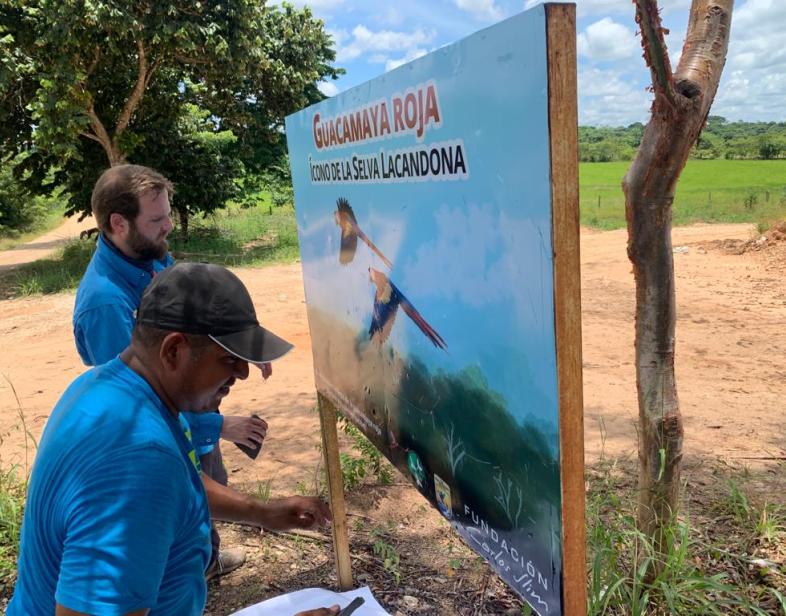An Overview Of Our Solution
Natura Mexicana (NM) protects the last viable scarlet macaw population in Mexico in the southern Montes Azules Biosphere Reserve (MABR), Chiapas. Our program combats the illegal traffic chain by involving locals in nesting site monitoring and reporting, and we rescue and manage nestlings threatened by illegal trade for their subsequent reintegration to the wild. These activities have decreased illegal nest looting in the region and resulted in the reintegration of 200+ individuals that otherwise would have ended in the illegal wildlife trade. We have established community monitoring groups that perform fluvial and terrestrial monitoring activities to assess population status and dynamics. Outreach activities with local communities reach more than 1000 adults and youth and have encouraged a change in perception locally towards revaluing the scarlet macaw.
- Population Impacted: 14000
- Continent: North America
Prénom
Nom de famille
Type d'organisation
Courriel
Analyse du contexte
MABR (330,000 ha) in the Lacandona Rainforest, Chiapas, is a protected area (PA) that represents the largest remaining tropical rainforest mass in Mexico.
The Lacantun River limits MABR from adjacent Marques de Comillas (MC) municipality (population 14000), where the local economy revolves around unsustainable farming and livestock activities. Most households in MC heavily rely on government subsidies geared towards these, a cause for further habitat loss leading to one of the highest deforestation rates countrywide (5%) and elicits enormous pressure on biodiversity. Aside from illegal wildlife trade, habitat loss is the single most significant threat to the scarlet macaw population.
An increased demand for land from younger generations coupled with a lack of economic alternatives in the region has put pressure on PAs, prompting repeated attempts to illegally invade MABR to establish farming settlements.
These converging economic, social, political, and environmental factors have prompted civil society to undertake biodiversity conservation and sustainable development schemes that should be fulfilled by federal and state entities. NM implements a wide array of conservation and sustainable development-focused projects in the region, (the Scarlet Macaw Conservation Program, among others) working with 8 MC communities as well as with the indigenous Lacandon community
Décrivez la solution technique que vous voudriez voir le public cible adopter.
We wanted to reduce nest looting as the biggest threat to the scarlet macaw and instill a change in perception towards the species within the local population of MC.
Firstly, we want younger generations to value the scarlet macaw as an icon that represents the region´s biodiversity and generates a sense of collective pride within communities.
As community-owned ecotourism being another of NM´s projects in MC, secondly, we wanted to convey the message that not only the scarlet macaw´s permanence as a colourful and highly charismatic bird species, but the permanence of biodiversity as a whole, can positively impact communities by attracting ecotourism revenue.
Third, we wanted to shame nest looting as an opportunistic source of income and involve locals in activities oriented towards the prevention of the species' illegal trade, such as the protection of nesting and feeding areas, and the generation of knowledge regarding the scarlet macaw population in the region.
Décrivez votre intervention comportementale.
We encourage reporting of nesting sites by supporting locals with an economic incentive designed to preserve them for future breeding seasons. As a result, we have seen an increase in active nest reporting from locals as it is a win-win for them as they have an incentive to have these clutches rescued and reintegrated rather than looted illegally as it happens so frequently. As an added benefit, locals voluntarily commit as long term program participants allowing for monitoring and rescue of their nesting sites on a yearly basis.
Through community outreach activities we have spread the program´s reach, intent and importance, informing people on the protected status of the scarlet macaw and consequences of its illegal trade. Now, the program reaches more people by word of mouth, thus increasing the number protected nesting sites by twofold in the last five years.
Working with local authorities has meant strengthened regulations to prevent and enforce local sanctions on nest looting.
The program´s network of community monitors hold participative workshops in which they are regularly updated in monitoring techniques and supplied with bird monitoring equipment and tools. Monitoring data gathered by them is used to constantly feed a database on scarlet macaw population dynamics and has produced an estimate of the total scarlet macaw population in the region (600 individuals). As a result, the generation of community science is being promoted.
Leviers comportementaux utilisés
Au besoin, veuillez expliquer comment vous avez utilisé le ou les leviers avec plus de détails.
Emotional appeals-We have aimed to foster a sense of pride within MC locals as guardians of MC´s biodiversity and conversely, instill a prospect of shame towards individuals who partake in nest looting as well as fear of the consequences that may result from the illegal trade of the species as protected under Mexican and international law.
Information-Informative workshops touch on subjects such as the species cultural and ecological importance as well as its value to the region as a natural appeal. Workshops serve as a means to advertise the program´s reach and availability to all local participants.
Material incentives-We incentivize surveillance of nesting sites and the reporting of nesting activity by landowners through a one-off payment designed to encourage nesting area preservation for future breeding seasons. This allows for timely intervention in rescue of threatened clutches.
Rules and Regulations-Promote enforcement of sanctions at community-level normativity.
Décrivez votre mise en œuvre.
Since 2005, NM´s presence in the region has enabled NM to build trusting relationships with the Lacandon indigenous community and adjacent communities of MC.
NM operates three research stations strategically positioned on MABR´s southern limit. These provide logistic and surveillance capacities the Lacandons lack, i.e., fluvial and aerial reconnaissance providing timely alert to authorities on illegal attempts to invade MABR, apart from other illegal wildlife activity.
In MC, habitat loss is addressed in two ways. First, NM serves as technical advisor to landowners in facilitating their participation in CONAFOR´s national Payment for Environmental Services (PES) program. Participants receive an annual stipend for the conservation of rainforest patches within their communities.
Secondly, NM has built an ecotourism network around such patches to secure their long-term conservation by procuring funding and accompanying operational activities on five, 100% community-owned ecotourism ventures in five different MC communities. This offers sustainable economic alternatives to locals: landowners receive yearly dividends as venture partners, and their families have secure income in the form of jobs.
We work to develop normativity for wildlife protection and enforce sanctions at a community level with local authorities of 8 communities in MC.
Outreach activities have resulted in higher participation in the scarlet macaw conservation program and active nest reporting to prevent illegal looting is on the rise.
A key factor for NEM´s continuity in the region has been to fulfil communities’ expectations on the projects we implement and always keep our end of the bargain. We are cautious with external entities that want implement projects within the communities as so often they fail to deliver, generating a hard to reverse mistrust.
Décrivez le leadership de votre solution. Qui dirige la mise en œuvre?
NM´s director, Biol. Javier de la Maza is known for his studies in Mexican lepidopterology and founder of CONANP (National Commission of Natural Protected Areas). He started his work in the Lacandona rainforest in the 1970s building Chajul Research Station as a base for conservation and academic activity, operating uninterrupted for the last 34 years. He oversees implementation of wildlife conservation projects.
MSc Biol. Julia Carabias, former National Environment Secretary and renowned conservationist contributes her vast expertise to develop NM´s current array of projects, to address the region´s environmental and social challenges from an integral and sustainable perspective.
The scarlet macaw conservation program is implemented by a team of three biologists in their thirties, whose expertise in tree climbing techniques, management of rescued nestlings, and community outreach activities contribute to fulfil its objectives.
Principaux intervenants et partenaires du programme
NM´s scarlet macaw conservation project has partnered with WCS Guatemala and FCD Belize to form the Selva Maya Alliance for the Conservation of the Scarlet Macaw which works to preserve the population of the Central American subspecies (Ara macao cyanoptera) across the three countries and share insights into its population dynamics and migratory behavior. We exchange experience on monitoring techniques, protection schemes and inference on public policy.
The Schubot Lab of Texas A&M University´s Veterinary Science Department collaborates with NM´s scarlet macaw program through nutritional studies to assess nestling health and development. They have shared their expertise in artificial nest placement techniques to increase offer of available nesting cavities, a component that has increased nesting success in recent years. They have also been kind enough to donate nestling management equipment.
Hill Country Aviaries in Texas visit the scarlet macaw project on a yearly basis. They share nestling management techniques that have contributed significantly to the project´s reintegration success rate.
All of NM´s projects articulate to converge on the conservation the natural ecosystems of the Lacandona rainforest and to develop sustainable alternatives for its inhabitants. This, in turn, relieves pressure of farming and livestock activities in the region and directly contributes to the preservation of the region´s biodiversity.
Qui a adopté le(s) comportement(s) souhaité(s) et dans quelle mesure?
Local landowners are more likely to report active nests now than in the past, knowing that unreported, nests are more than likely looted. Reports in MC increased twofold in the last five years and NM monitors upwards of two-dozen nesting sites in community land.
The formation of youth monitoring groups in four communities have resulted in children understanding the importance of the species´ role in the ecosystem as seed predators and dispersers. Opposed to before, most wanted to capture macaws to keep as pets. Our youth monitoring program is coupled to workshops as well as ludic activities coupled with environmental education materials. These youth monitoring groups have grown steadily every year, now counting more than 60 children from the 12 we started 2 years ago.
The change in behavior in these two population groups is evident by its steady increase over time and it is now rare to see captured individuals kept as pets in MC´s households.
Quel a été votre impact sur la pollution de l'eau?
Monitoring records show roughly between 6-9% increase in raw scarlet macaw numbers in the Lacantun river basin compared to nine years ago when monitoring activities started. This suggests the population in this area is on the rise. The program has rescued and reintegrated upwards of 200+ nestlings in 17 years with a survival rate of 95%+, thus adding a substantial share to the population´s estimated 400 individuals (Iñigo, 1994).
Reproductive success of breeding pairs is also increasing, as nesting sites are being protected and fledgelings are more likely to successfully abandon nests. Fledgelings are recognizable as they have more cumbersome flight demeanor and shorter tails than adults. Monitoring activity shows an increase in breeding pairs with fledgelings on the months after the breeding season (May, June, July, and August) in the Lacantun river basin.
Quel a été l'impact de votre solution sur les problèmes d'équité?
NM, the only permanent employer in the region, sustains 30 jobs for MC locals who receive steady salaries and full benefits.
Participants in the scarlet macaw protection program receive an economic incentive nest reporting, a significant contribution to an average MC household, most of which have no steady income and rely on selling crop´s surplus to buy basic goods.
Community- owned ecotourism ventures bring revenue to dozens of families of MC´s communities as well as permanent and temporary jobs. Moreover, these enterprises prioritize employment of women and youth contributing to level the breach in a male-dominated society.
NEM has helped channel roughly USD$750,000 in PSA support to hundreds of families in MC over the last decade.
Quels étaient les avantages sociaux ou communautaires de votre solution?
The scalet macaw is an “umbrella” species, meaning efforts for conservation of its habitat protects all biodiversity cohabiting its ecosystem.
Boca de Chajul´s school truck fuel is sponsored by NM, enabling youth from five other communities to attend and not bear transporting costs.
Snakebite is common in MC where antivenom is scarce/outdated or a 4-hour drive away. A fully stocked Chajul Station readily hands antivenom out for free to anyone in need in MC communities in case of accident.
Quels ont été les avantages connexes de votre solution par rapport au développement durable?
Although it has taken years, people in MC have started to realize, contrary to what they believed to be true, that they can make a living out of a conserved ecosystem, that a macaw´s recurring nesting is more valuable, monetarily speaking, than downing a tree once to loot a clutch.
They realize outsiders are willing to pay top dollar see the region´s biodiversity, which they take for granted. And just now they are realizing income from sustainable activities is beginning to outweigh others.
Durabilité : Décrivez la durabilité économique de votre solution.
Across its wide array of projects, NM continuity has been based on its members’ awareness of the importance of biodiversity conservation in such an ecosystem, aside from determination, teamwork, work ethic, and organizational and fund-raising capacities.
For as long as we can both secure funding and the socio-political context in the region allows for our presence, we will continue to work for the Lacandona´s sustainable development and biodiversity conservation.
Retour sur investissement : Combien a coûté la mise en œuvre de ces activités?
NM´s infrastructure has been built through several funding stints across more than three decades. Therefore, the three research stations we are based off will not be considered and hence the total cost reflected below.
Yearly running costs unless otherwise specified:
USD$20k on nestling management facilities (one off payment)
USD$8k maternity lab, monitoring equipment and training.
USD$3k tree climbing equipment.
USD$2-3k nest reporting support
USD$30k yearly salaries
USD$15k food, fuel, transport
USD$8k administrative costs
USD$8k overhead
TOTAL USD$95,000.00
Considering the program is working to conserve the last scarlet macaw population in Mexico and has produced positive results, we deem these costs to be reasonable.
Comment pourrions-nous reproduire cette solution ailleurs avec succès?
For replication, location conditions are key. If illegal traffic is absent, rescue/management becomes redundant.
In Guatemala, where roughly 60 nestlings per year are rescued, they learn to fly in a flight cage before release. Here, they are encouraged by other macaws to fly freely, occasionally returning for monitoring. In Belize, armed personnel camp at nesting trees until chicks fledge.
In any case, if tree climbing is to be performed, training on techniques and safe equipment operation is necessary.
In NM´s case, lightbulbs used as heat sources for nestlings were eventually replaced by brooders with controlled humidity and temperature conditions. On the other hand, our feeding formula has not changed in over a decade.
These examples illustrate how economic or costly a solution may be replicated. On the low side, we estimate USD$20k would be enough to implement a project like this in Latin America. If necessary, we are happy to share what we have learned along the way.
